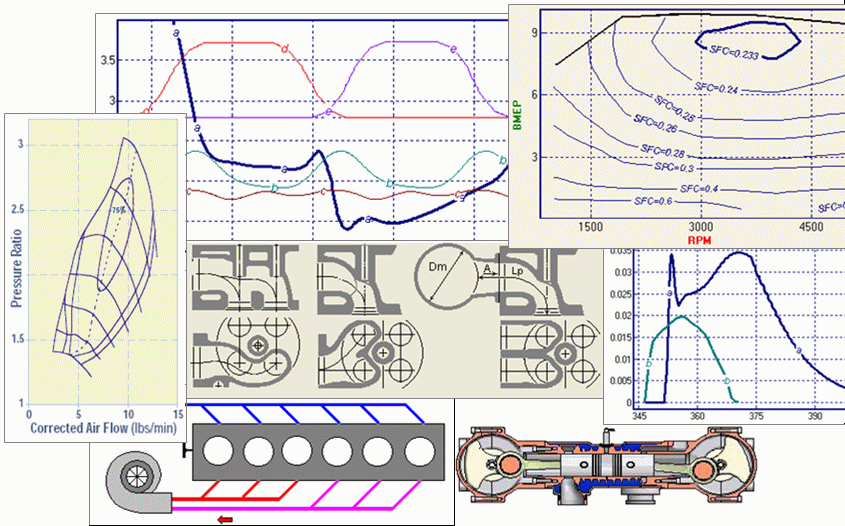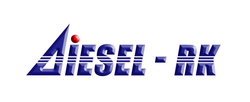Calculation models used in the DIESEL-RK
Selection of engine models used in the DIESEL-RK is
stipulated by the requirements of a high accuracy of results, high rate of calculation and
generality. The last condition is a reason of refusal from empirical equations, which
are correct only in narrow boundaries. Authors have preferred frequently laborious methods
which consider the physical nature of phenomena in engines. A number of calculation
methods was developed by authors of this project.
Mathematical models of main phenomena in engine are described in
Dr. Sc. (Tech) Dissertation of Prof. A. Kuleshov: Simulation and Optimization of ICE Working Processes

- The parameters of gas in cylinders and manifolds of an engine are defined by
step-by-step solution of the system of difference equations of conservation of energy,
mass, and also equation of state written for open thermodynamic systems. The dependence of
properties of gas on a composition and temperature is taken into account. The method of
difference equations exceeds conventional ones in an accuracy and rate one-fifth as large.
- To calculate combustion in
petrol and gas engines including prechamber engines a multizone model is used. The
rate of heat release is calculated by Wiebe method.
- Mixture formation and combustion in diesel engines are simulated with RK-model. Simulation
method of RK-model was developed by Prof. Razleytsev in 1990-1994. After this method was
modified and complemented by Dr. Kuleshov. RK-model takes into
account:
The method takes into account conditions of evolution of each fuel spray and
near wall flows generated by sprays, and also interaction between near wall flows. RK-model
allows determination the emission of soot and emission of NO depending on mixture
formation and combustion conditions. The software makes it possible to find the optimum of
piston bowl shape, fuel sprays directions, diameters and numbers of nozzles, intensity of
air swirl and the injection profile shape.
- Calculation of NO emission is carried out by two ways.
- Technique developed by Prof. Zvonov with using
Zeldovich mechanism on the base of
chemical equilibrium estimated by 18 species for conventional diesels.
- Detail Kinetic Mechanism
(DKM) (199 reactions, 33
species) for correct prediction of NO emission in
engine with large EGR, multiple injection and HCCI. DKM is supported by the local release of DIESEL-RK.
- Soot emission model was developed by Prof. Razleytsev.
- Design of EGR system is taken into account.
- A model of gas exchange
takes into account a non-steady gas flow in ports, design of engine ports, influence of
the neighboring cylinders and the pulse converter design. Two-stroke engine scavenging
model including perfect mixing, perfect displacement and short closing being used. It
permit a computational optimizing of valve timing, and also determining the best
configuration of intake and exhaust ports of two-stroke engines.
- A heat transfer is simulated separately for different surfaces . The surfaces
temperatures are determined by the decision of a heat transfer equation. Coefficient of
gas-walls heat transfer in cylimder is determined by the Woschni's formula.
Heat transfer in valve and piston controlled ports as well as in manifolds is taken into
account.
- Parameters of turbines and compressors are determined by different ways:
a) set explicitly or calculate on pressure ratios and efficiency including
power balance of turbocharger at each operating mode;
b) matching of turbine and compressor maps with a piston engine.
The technique of joint calculation of an internal combustion engine and units of
turbocharging on various operating modes allows predicting the performances of
turbo and supercharged engines:
- at variation of speed,
- at variation of torque,
- at variation of height of flight,
- at variation of diving depth in the sea and others.
Selection of turbocharging units for maintenance of the required characteristics of the
supercharged engine is also possible.
DIESEL-RK supports modeling and research of engines with two-stage turbocharging, Hiperbar
systems, etc.
The program DIESEL-RK makes it possible to simulate a
working process of any type of internal combustion engines. Applied calculation models
provide high accuracy of results.
The experience of usage of the program in modeling and
researches of engines with different size and application has shown that the program needs
no preliminary set-up of empirical coefficients for a concrete engine. It is enough to use
Wizard of New Project Creation. This wizard on the basis of the most common data
on researched engine will generate files of input data, using the most known technical
decisions accepted in area of propulsion engineering. Thus essentially becomes simpler not
only process of input data entering but also the most difficult stage of computational
research: calibration of engine model. The last is especially important for the students
who are not having enough experience, time and experimental data for customizing of the
program on object of research, and also for researchers who makes express estimation of an
ICE design.
To obtain authentic calculation results, if you search for
the ways of improvement of the engine performances or the ways of decrease of harmful
materials emission, etc., it is necessary to carry out the comparison between calculated
and measured data for a base engine configuration at several regimes and calibrate models
if mismatch occur.
The amount of empirical coefficients is not great, and they are
strictly constant for any operating regimes of engine and for any its configuration.
Calibrated calculation model provides accuracy simulation of
engine over whole operating range with identical values of empirical coefficients. It
makes it possible to use DIESEL-RK for development of controlling algorithm of fuel
injection system over whole operating range including part load and idling.
To home page










|



